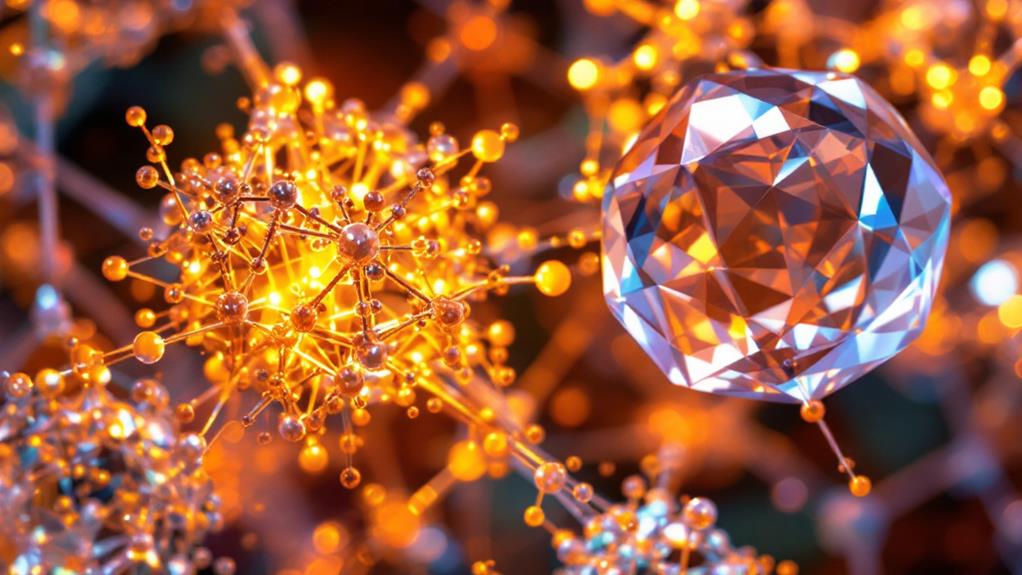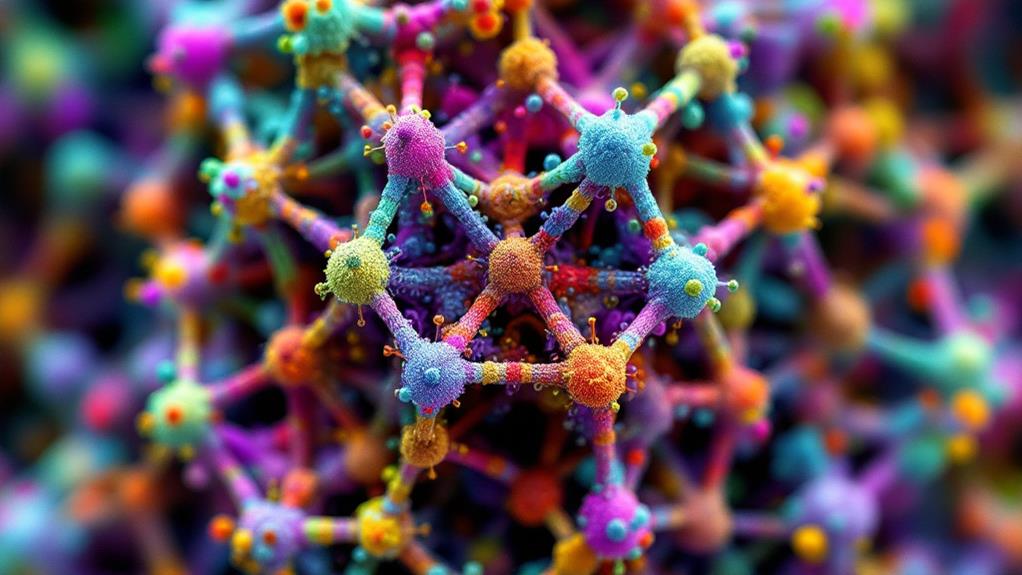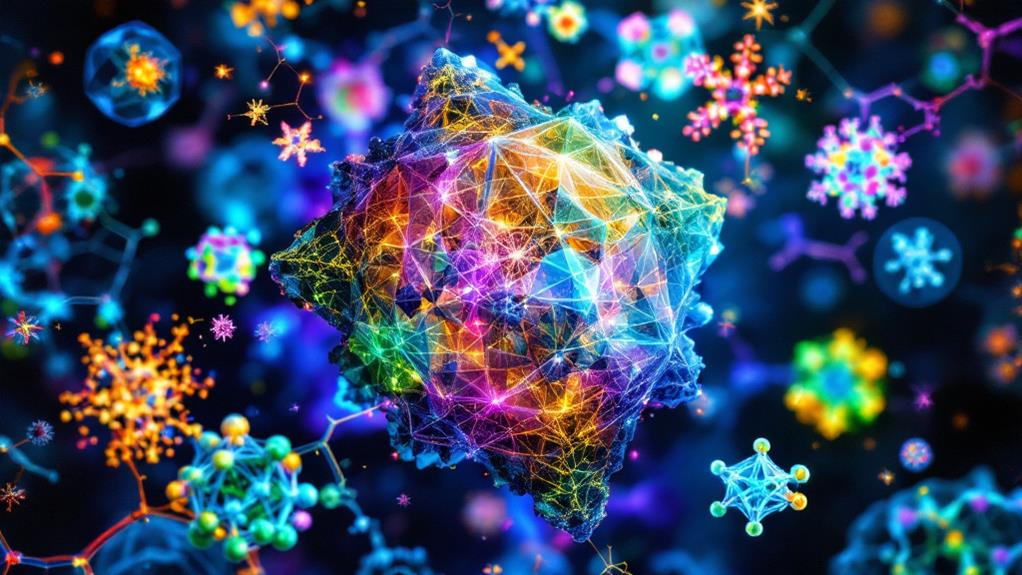A Comprehensive Guide to Crystallography: The Study of Crystal Structures

Crystallography investigates the secrets of atomic arrangements in materials, shaping our understanding of nature and technology. You'll probe crystal formation, from nucleation to growth, and learn how X-ray diffraction and electron microscopy techniques reveal intricate structures. Uncover applications across chemistry, biology, physics, and geology, revolutionizing fields like drug design and mineral identification. Emerging trends, including computational methods and serial crystallography, are pushing the boundaries of what's possible. By grasping the fundamentals and frontier developments in crystallography, you'll acquire knowledge into the building blocks of matter and their far-reaching implications. The atomic world awaits your examination.
Fundamentals of Crystal Formation
Crystals, nature's geometric marvels, form when atoms or molecules arrange themselves in a highly ordered, repeating pattern. This process begins with crystal nucleation, where tiny clusters of atoms or molecules come together to create a stable seed. These seeds serve as the foundation for further growth.
Once nucleation occurs, crystal growth mechanisms take over. You'll find that atoms or molecules attach to the existing structure in specific orientations, following the pattern established by the seed. This growth can happen through various methods, including vapor deposition, solution growth, and melt growth.
As the crystal grows, it develops distinct faces, edges, and vertices. The internal structure determines these external features, creating the characteristic shapes you see in different types of crystals. Factors like temperature, pressure, and the presence of impurities can influence the growth process and resulting crystal structure.
Understanding these fundamentals is essential for controlling crystal formation in various applications, from manufacturing semiconductors to growing gemstones. By manipulating growth conditions, you can tailor crystals for specific uses in technology, medicine, and materials science.
X-ray Diffraction Techniques
In light of the need for accurate structural analysis, X-ray diffraction stands out as a powerful technique for probing the atomic arrangement within crystals. When you use X-ray diffraction, you're essentially bombarding a crystal with X-rays and observing how they scatter. This scattering pattern provides priceless information about the crystal's internal structure.
To interpret the diffraction pattern, you'll need to employ peak indexing. This process involves assigning Miller indices to each observed diffraction peak, allowing you to relate the peaks to specific planes within the crystal lattice. Once you've indexed the peaks, you can move on to structural refinement. This step involves repetitively adjusting a proposed structural model to better match the observed diffraction data.
You'll find that modern X-ray diffraction techniques often utilize synchrotron radiation, which provides intense, highly focused X-ray beams. This allows for the study of extremely small crystals or even time-resolved experiments. Additionally, you can combine X-ray diffraction with other techniques, such as spectroscopy or microscopy, to gain a more thorough understanding of your crystal's properties and behavior.
Electron Microscopy in Crystallography

Building upon X-ray diffraction techniques, electron microscopy offers a complementary approach to crystallographic analysis. This powerful method uses high-energy electron beams to image crystal structures at atomic resolution. You'll find that electron microscopy provides unique advantages in studying crystalline materials, especially when dealing with nanocrystals or beam-sensitive samples.
Electron beam imaging in crystallography allows you to:
- Visualize individual atoms and their arrangements within the crystal lattice
- Observe defects, dislocations, and grain boundaries in real-time
- Study variable processes, such as phase transitions and crystal growth
- Analyze the composition and structure of complex materials at the nanoscale
When you're working with electron microscopy for crystallography, you'll encounter various techniques, including transmission electron microscopy (TEM) and scanning electron microscopy (SEM). These methods enable atomic resolution imaging, providing detailed information about crystal structures that complement X-ray diffraction data. By combining electron microscopy with other crystallographic techniques, you'll gain a more extensive understanding of crystal structures and their properties, enhancing your ability to design and characterize advanced materials for various applications.
Applications Across Scientific Disciplines
Crystallography frequently extends its reach far beyond the confines of materials science, impacting numerous scientific disciplines. You'll find its applications in chemistry, where it's vital for understanding molecular structures and bonding. In biology, crystallography helps decipher the complex structures of proteins and nucleic acids, aiding drug design and molecular biology research.
In physics, you'll use crystallography to study the atomic arrangements in solids, shedding light on their physical properties. It's essential in geology for identifying and classifying minerals. In archaeology, you can employ crystallographic techniques to analyze ancient artifacts and determine their composition.
Materials characterization heavily relies on crystallography, allowing you to investigate the structure-property relationships of various materials. This knowledge is priceless in developing new materials with customized properties for specific applications.
Computational crystallography has revolutionized the field, enabling you to simulate and predict crystal structures, analyze diffraction data, and solve complex structures more efficiently. It's become an indispensable tool in modern research, bridging the gap between experimental observations and theoretical understanding across multiple scientific disciplines.
Emerging Trends in Crystallographic Research

As the field of crystallography continues to evolve, several exciting trends are shaping its future. You'll find that researchers are increasingly leveraging advanced computational methods to enhance their comprehension of crystal structures. Data mining techniques are now being applied to vast crystallographic databases, allowing scientists to uncover hidden patterns and relationships within crystal systems.
Another emerging trend is the integration of molecular modeling simulations with experimental data. This approach enables you to predict and validate crystal structures with unparalleled accuracy. You're also likely to encounter:
- The rise of serial crystallography for studying dynamic processes
- Increased use of artificial intelligence in structure determination
- Development of in situ crystallization techniques for real-time observations
- Advancements in high-pressure crystallography for exploring extreme conditions
These trends are pushing the boundaries of what's possible in crystallographic research. As you explore deeper into the field, you'll discover how these innovations are revolutionizing our understanding of materials at the atomic level. Keep an eye on these developments, as they're likely to shape the future of crystallography and its applications across various scientific disciplines.



